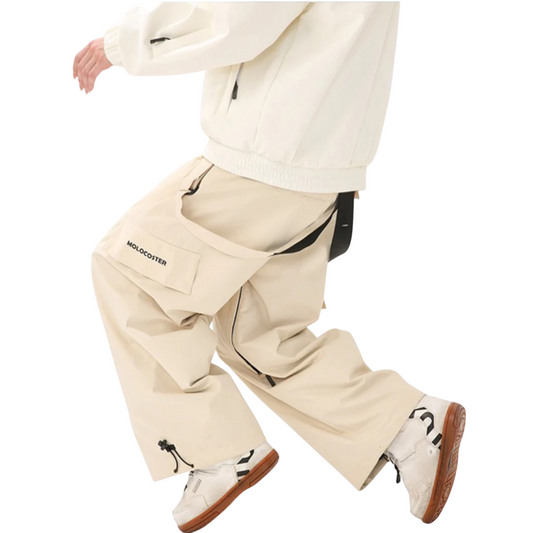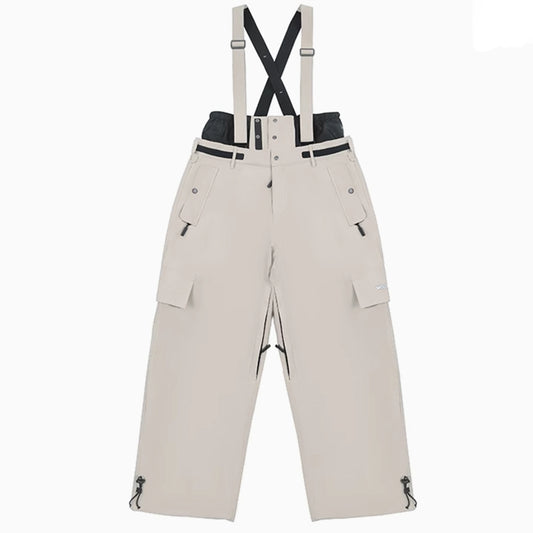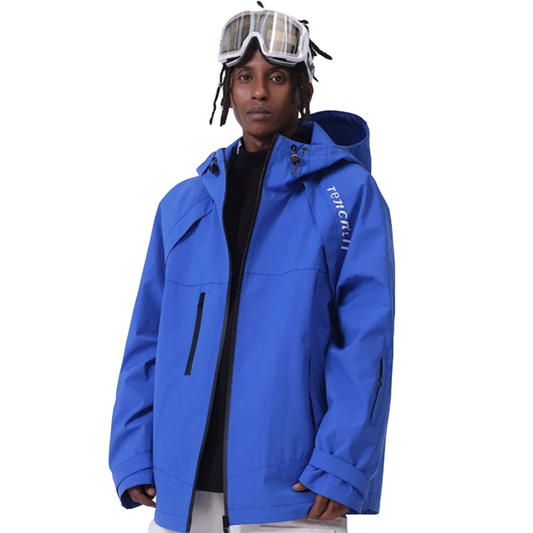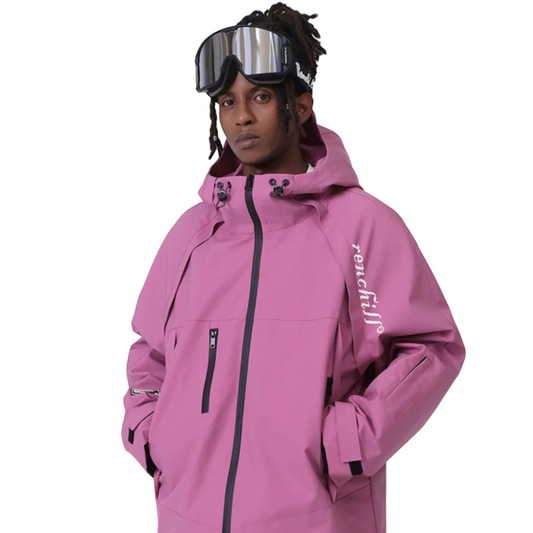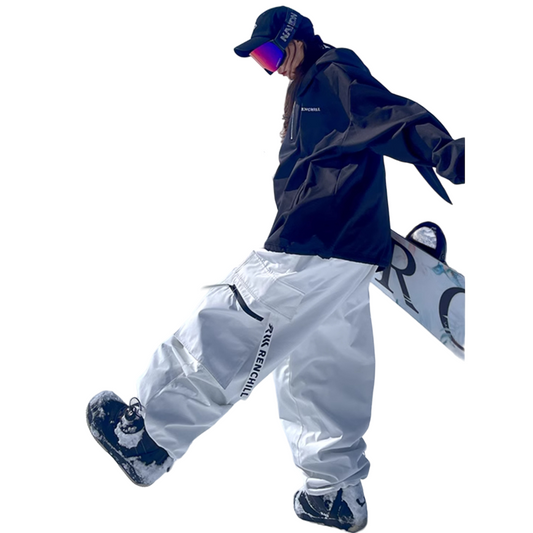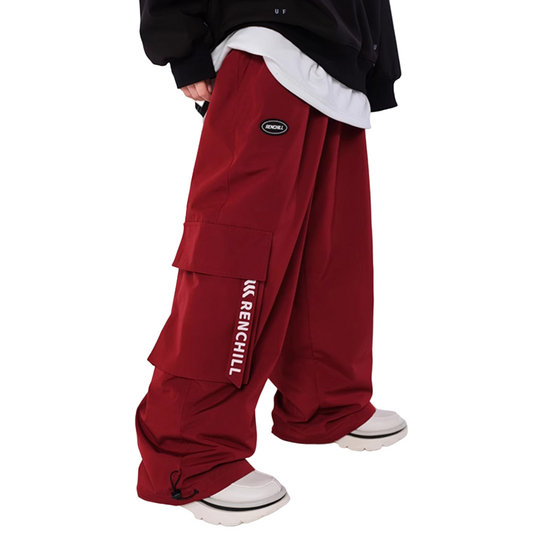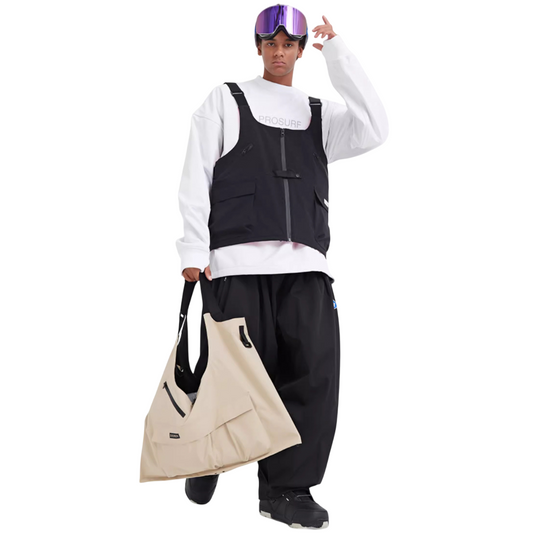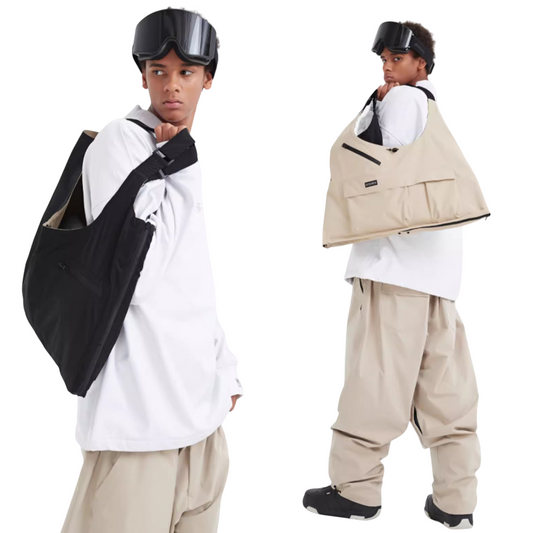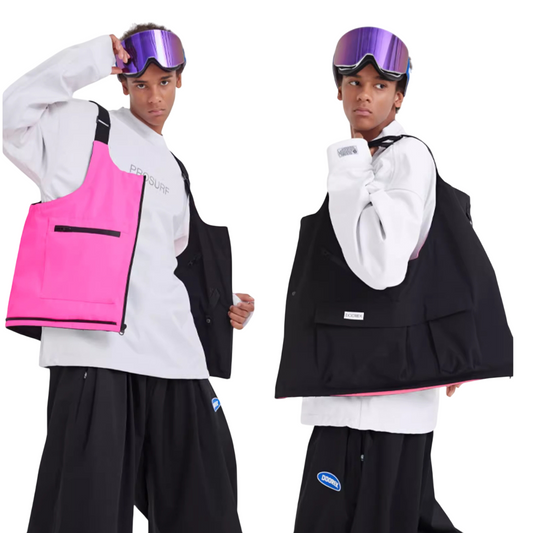You want the best waterproof ski jackets for snowboarding in 2025 to deliver a waterproof rating of at least 20,000 mm, top-tier breathability, and a fit that supports movement. Look for the best ski jacket with Gore-Tex, seam taping, pit zips, and a freeride cut. SNOWMOCACA offers trusted quality and free shipping on orders over $99. 🏂
Consider these features for your best ski jacket:
- Gore-Tex Pro Shell or ePE for waterproofing and breathability
- Waterproof zippers and pit zips for comfort
- Helmet-compatible hoods and powder skirts
|
Market Segment |
Year |
Market Size (USD Billion) |
CAGR (%) |
Notes |
|---|---|---|---|---|
|
Waterproof Jackets Market |
2023 |
2.7 |
8.2 |
Projected to reach 5.4 billion by 2032 |
|
Ski Sports Jacket Market |
2023 |
2.5 |
6.5 |
Projected to reach 4.5 billion by 2032 |
|
Ski Clothing Market |
2025 |
N/A |
2.0 |
Forecasted to reach 1.59 billion by 2033; the broader category includes jackets and others |
Key Takeaways
-
Choose a ski jacket with a waterproof rating of at least 10,000 mm to stay dry in most conditions; look for fully taped seams and waterproof zippers for extra protection.
-
Pick a jacket with good breathability (10,000 to 20,000 g/m²/24h) to let sweat escape and keep you comfortable during active snowboarding.
-
Select the right jacket type—shell for layering and mobility, insulated for warmth, or 3-in-1 for versatility—to match your riding style and weather needs.
Best Waterproof Ski Jackets: What Matters
Waterproof Ratings
When you look for the best waterproof ski jackets, you need to pay close attention to the waterproof rating. This rating tells you how much water the fabric can handle before it starts to leak. Manufacturers measure this by placing a tube over the fabric and seeing how many millimeters of water it can hold before water seeps through. A jacket with a 3,000 mm rating only keeps you dry in light drizzle. If you ride in cold, clear weather, a 5,000 mm rating works for short periods outside. For most snowboarders, a 10,000 mm waterproof rating is the industry standard. It keeps you dry on regular days and offers solid protection against snow and light rain. If you ride in wet climates or face heavy snow, you should look for jackets with ratings between 15,000 mm and 20,000 mm or higher. These jackets give you the best weather resistance and keep you dry even during long days on the mountain.
You also want to check for features like fully taped seams and waterproof zippers. These details stop water from sneaking in through stitching or openings. Many of the best waterproof ski jackets use Gore-Tex or similar membranes. Gore-Tex stands out for its waterproof and breathable qualities, making it a top choice for snowboarders who want reliable weather resistance and long-lasting performance.
Tip: Always check the waterproof rating before you buy. Higher numbers mean better protection in harsh weather.
Breathability
Breathability is just as important as waterproofing when you choose a ski jacket. When you ride hard, your body sweats. If your jacket does not let moisture escape, you end up wet and cold from the inside. Breathability ratings show how much water vapor can pass through the fabric in 24 hours, measured in grams per square meter (g/m²/24h). For casual cruising, a rating of 5,000 to 10,000 works. If you push yourself with moderate activity, look for 10,000 to 15,000. For intense riding or backcountry trips, you need at least 20,000 to stay dry and comfortable.

A breathable jacket helps sweat and condensation escape, which keeps you dry and prevents overheating. Scientific studies show that breathable fabrics with sweat management improve comfort and performance. These fabrics guide sweat away from your body and protect the insulation layer, so you stay warm and dry. Remember, the best waterproof ski jackets balance waterproofing and breathability for all-day comfort.
Here is a quick guide to breathability ratings:
|
Breathability Range (g/m²/24h) |
Activity Intensity |
Recommended Use for Snowboarders |
|---|---|---|
|
5,000 - 10,000 |
Light perspiration |
Casual cruising |
|
10,000 - 15,000 |
Moderate exertion |
Moderate activity with bursts of effort |
|
15,000 - 20,000 |
High perspiration |
Intense activity like hot laps |
|
20,000+ |
Extreme perspiration |
Prolonged, intense activity (backcountry) |
Durability
Durability matters when you want your jacket to last through many seasons. Snowboarding puts your gear to the test. You face falls, sharp edges, and rough chairlifts. The best waterproof ski jackets use tough materials like high-denier nylon or polyester. These fabrics resist rips and tears. Jackets often have reinforced areas on the shoulders, elbows, and cuffs to handle extra wear.
Many jackets use a Durable Water Repellent (DWR) coating on the outer fabric. This coating makes water bead up and roll off, giving you extra protection. Over time, DWR wears off, so you need to reapply it to keep your jacket waterproof and breathable. Seam sealing with high-quality tape stops water from leaking through the stitching. Some jackets use welded seams for even better weather resistance.
Here are some key factors that boost durability and performance:
|
Factor |
Description |
Contribution to Durability and Waterproofness |
|---|---|---|
|
Waterproof Membranes |
Gore-Tex, eVent, Omni-Tech (ePTFE or PU-based) |
Provide a waterproof and breathable barrier, preventing water ingress while allowing vapor escape |
|
Fabric Denier |
Measured in denier (thread weight), range from 30D to 150D+; ballistic fabrics up to 1200D |
Higher denier fabrics resist abrasion and cuts better, enhancing durability |
|
Construction Method |
3-layer fabric construction (face fabric + membrane + backing lining) |
Offers superior protection, durability, and breathability, ideal for extreme conditions |
|
Seam Construction |
Sewn seams sealed with high-quality seam tape; welded seams for lighter, hole-free waterproofing |
Sewn seams provide strength; seam tape prevents water ingress; welded seams reduce bulk and holes |
|
Stitch Density |
14-16 stitches per inch (Arc’teryx standard) vs. industry 8-10 stitches per inch |
Higher stitch density results in stronger, longer-lasting seams |
|
Thread Quality |
Heavy #40 weight 100% polyester thread |
Resists UV rays and abrasion better than common threads |
|
Reinforcements |
Reinforced areas, waterproof zippers, powder skirts |
Enhance overall durability and waterproof performance |
You should also watch for common causes of wear and tear. Friction from falls, sharp snowboard edges, and snagging on branches can damage your jacket. Reinforced zones and abrasion-resistant fabrics help your jacket stand up to these challenges. Proper care, like washing and storing your jacket as the manufacturer suggests, keeps it performing at its best.
Choosing the Best Ski Jacket: Types
When choosing the best ski jacket for snowboarding, you need to understand the main types: shell jackets, insulated jackets, and 3-in-1 jackets. Each type offers unique benefits for different weather and riding styles.
|
Description |
Warmth |
Breathability |
Fit & Mobility |
Weight |
Cost & Value |
|
|---|---|---|---|---|---|---|
|
Shell |
Non-insulated outer layer focused on waterproofing and wind protection; relies on layering for warmth. |
Low; depends on layers |
High, especially premium shells |
Streamlined; best mobility |
Lightest option |
Can be expensive; saves money if paired with midlayers |
|
Insulated |
Built-in synthetic or down insulation for warmth; adds bulk and may reduce mobility. |
High, good for cold |
Lower than shells |
Bulkier; less mobility |
Heavier |
Mid to high cost; great for cold days |
|
3-in-1 |
Waterproof shell and zip-in insulated liner; versatile and budget-friendly. |
Moderate; depends on the liner |
Moderate |
Less tailored; reduced mobility |
Heavier than shells |
Best value for casual users |
Shell Jackets
A shell ski jacket gives you maximum protection from snow, rain, and wind. You get high breathability and the lightest weight, which means you can move freely. Shell jackets do not have built-in warmth, so you must add base and mid layers for cold weather. This flexibility lets you adjust for changing weather or activity. You can wear just a shell on warm spring days or add layers for deep winter. Shell jackets work well if you want the best ski jacket for all seasons and like to control your warmth.
Tip: Shell jackets are perfect if you ride in wet climates or need a jacket for both snowboarding and rainy days.
Insulated Jackets
Insulated jackets combine a waterproof shell with built-in insulation. You get reliable warmth, which is great for cold weather or resort riding. Down insulation gives you the most warmth for the weight but works best in dry conditions. Synthetic insulation keeps you warm even when wet, making it a smart choice for variable weather. An insulated ski jacket often feels bulkier and less breathable than a shell, but you stay comfortable on freezing days. Choose insulated jackets if you want the best ski jacket for cold climates and do not want to worry about layering.
3-in-1 Jackets
3-in-1 jackets offer the most versatility. You get a waterproof shell and a removable insulated liner. Wear the shell alone for wet weather, the liner alone for mild days, or both for full warmth in harsh weather. This system adapts to changing conditions and activity levels. 3-in-1 jackets give you good value and convenience, though they may feel heavier and less fitted than other options. If you want one jacket for all weather and easy layering, 3-in-1 jackets make choosing the best ski jacket simple.
SNOWMOCACA Ski Jacket
Features & Benefits
When you look for the best ski jacket, you want something that stands out in every way. The SNOWMOCACA Ski Jacket brings together advanced technology and thoughtful design. You get a jacket that keeps you comfortable and protected on the slopes. Here are some standout features that make this the best ski jacket for snowboarding in 2025:
-
Medium-weight synthetic insulation (60gsm in the body, 40gsm in the sleeves and hood) balances warmth and mobility. You stay warm without overheating.
-
A bonded waterproof membrane rated at 28,000 mm gives you superior water resistance. This rating is much higher than most youth jackets, making it the best ski jacket for wet conditions.
-
PFAS-free Durable Water Repellent (DWR) treatment and fully taped seams keep water out, even in heavy snow.
-
Underarm vents improve breathability, so you stay dry and comfortable during active runs.
-
Water-resistant SBS zippers and strong materials add durability. You can count on this jacket to last through many seasons.
-
Adjustable hood, detachable snow skirt, elastic cuffs with thumb holes, adjustable hem, 3D tailoring, and stretchy panels give you a custom fit and freedom of movement.
These features work together to make the SNOWMOCACA Ski Jacket the best ski jacket for warmth, waterproofing, breathability, durability, and fit.
Free Shipping Offer
You can get the best ski jacket delivered to your door with free shipping on orders over $99. This offer helps you save money while getting top-quality gear. If you want to learn more about the latest features, trends, and tips, visit the SNOWMOCACA blog for helpful guides and updates.
Essential Features for Snowboarders
When you choose a ski jacket for snowboarding, you need to focus on must-have features that boost comfort and protection. These performance features help you stay dry, warm, and organized on the slopes.
Seam Taping
Seam taping is one of the most important features for a waterproof jacket. Stitching creates tiny holes in the fabric, which can let water in. Seam taping covers these holes with a special waterproof tape. You will find two main types: fully taped seams and critically taped seams. Fully taped seams cover every seam, giving you the highest level of protection against snow and rain. Critically taped seams only protect the most exposed areas, like the shoulders and hood. For the best waterproof protection, look for jackets with fully taped seams.
Tip: Seam taping keeps you dry even in heavy snow or wet conditions, making it a must-have feature for serious snowboarders.
Hoods & Powder Skirts
Adjustable hoods and powder skirts are must-have features for snowboarders who want full protection from wind and snow. A good hood fits over your helmet and adjusts in several directions. This design blocks wind and snow, keeping your head and face warm. Powder skirts act as barriers at your waist. They snap or zip into place, stopping snow from getting inside your jacket during falls or deep powder runs. These features work together to keep you warm and dry, no matter the weather.
|
Feature |
Benefit for Snowboarders |
|---|---|
|
Adjustable Hood |
Shields face and helmet from wind/snow |
|
Powder Skirt |
Blocks snow from entering at the waist |
Pockets & Vents
Pockets and vents add convenience and comfort to your jacket. Multiple pockets let you carry essentials like your phone, snacks, or ski pass. Some pockets have waterproof zippers to keep your items dry. Specialized pockets protect electronics from cold, which helps your devices last longer. Underarm vents, also called pit zips, allow you to release heat and moisture when you get too warm. This ventilation keeps you comfortable during active riding or hiking. Together, these features improve your experience and help you adapt to changing conditions.
Remember: The right combination of waterproof, protective, and functional features will make your day on the mountain safer and more enjoyable. 🏂
Fit, Mobility, and Style

Sizing Tips
Choosing the right size ski jacket helps you stay comfortable and protected in all weather. You want a fit that lets you layer up for extra warmth and move freely on the slopes. Use these tips when picking your jacket:
- Pick a jacket that leaves a 2-3cm gap from your body. This space traps air for insulation and keeps you warm.
- Make sure the jacket overlaps your snow pants by at least 5cm when you bend your knees. This overlap blocks snow from getting inside.
- Look for extra coverage in the back. This protects you when you strap into your snowboard.
- Go for a relaxed or slightly oversized fit. This style gives you room to move but does not feel baggy.
- Choose a Regular Fit to fit base and mid-layers under your jacket.
- Adjustable hems and ventilation zippers help you control your temperature and mobility.
- Durable, waterproof fabrics like Gore-Tex keep you dry and comfortable in changing weather.
- Layer with fleece or thin synthetic down for warmth without losing movement.
Freedom of Movement
You need a jacket that supports every move you make on your board. Snowboard jackets often have a longer, baggier cut than ski jackets. This design gives you freedom to jump, carve, and tweak your tricks. A looser fit also makes it easier to strap in and out of your bindings. The extra length covers you when you sit or kneel in the snow. Both ski and snowboard jackets use this fit to help you move smoothly across the mountain. You get full coverage and layering options without feeling weighed down. Many riders prefer lightweight and breathable jackets for better comfort during active days.
Tip: A jacket that moves with you helps you ride longer and stay comfortable in any weather.
Trends: Vintage & Retro
In 2025, ski jacket styles bring back bold looks from the past. For women, you see pastel and bright colors like mint green, light pink, and lime yellow. Patterns such as animal prints, geometric shapes, and abstract designs are popular. Ton-sur-ton color schemes, where you mix shades of the same color, create a modern twist. Retro styles from the '70s, '80s, and '90s return with oversized fits, neon accents, and sporty designs. Many brands update their collections with these trends. For men and youth, you find a wide range of options, from classic to modern, so everyone can find a style that fits their taste and stands out in any weather.
Care and Maintenance
How to Wash Ski Jacket
Keeping your waterproof ski jacket clean helps it last longer and perform better. You should always check the care label before washing. Follow these steps for the best results:
- Close all zippers and turn the jacket inside out. This protects the outer layer and prevents damage.
- Use a liquid detergent made for outdoor gear. Regular detergents and fabric softeners can harm waterproof coatings.
- Wash the jacket in cold or lukewarm water (around 30°C) on a gentle or outdoor gear cycle.
- Run an extra rinse cycle to remove all detergent residue. Leftover soap can reduce water repellency.
- Air-dry the jacket in a well-ventilated area away from direct heat. If the care label allows, tumble dry on medium heat for 20–30 minutes to reactivate the water-repellent finish.
- Spot clean minor stains with a damp cloth and a small amount of mild detergent.
Tip: Do not wash your new jacket before first use. Wash after 3–5 uses or when you notice water no longer beads on the surface.
To restore waterproofing, use a DWR (Durable Water Repellent) treatment after washing. You can apply a wash-in or spray-on product, then dry the jacket as recommended.
Storage & Repairs
Proper storage and timely repairs keep your ski jacket in top shape. Hang your jacket on a wide hanger to avoid compressing the waterproof membrane. Store it in a cool, dry place away from direct sunlight. Avoid folding or stuffing it into tight spaces for long periods.
If you notice damage, such as worn seam tape or small tears, seek professional repairs. This helps maintain the jacket’s waterproof integrity. For minor issues, use repair patches or waterproof fabric tape as a temporary fix.
Note: Rinse off mud or salt with clean water after each trip to prevent stains and fabric damage. Regular care extends your jacket’s life and keeps you ready for every snowboarding adventure. 🧥
More Tips & Resources
What to Wear Under Ski Jacket
Choosing the right layers under your ski jacket helps you stay warm, dry, and comfortable while snowboarding. You should start with a base layer that fits close to your skin. This layer pulls sweat away and keeps you dry—Merino wool and synthetic fibers like polyester or nylon work best. Avoid cotton because it holds moisture and makes you cold.
Next, add a mid layer for insulation. Fleece, wool, or lightweight down traps heat and lets air move. Look for mid layers with features like thumb loops, zippered pockets, or a hood for extra warmth. Adjust the thickness of your mid-layer based on the weather.
|
Layer Type |
Key Features |
Recommended Materials |
Extra Notes |
|---|---|---|---|
|
Base Layer |
Snug, moisture-wicking, smooth on skin |
Merino wool, polyester, nylon |
Look for flat seams and mesh panels for comfort |
|
Mid Layer |
Insulating, breathable, and traps body heat |
Fleece, wool, hydrophobic down |
Choose athletic cuts with thumb loops and zippered pockets |
Tip: This layering system manages sweat, keeps you warm, and lets you move freely on the mountain. 🧦🧥
Best Affordable Ski Jackets
You can find ski jackets that balance cost, warmth, and waterproofing. Many affordable options work well for beginners or short trips. When you shop, look for jackets that resist wet snow and wind, but do not worry about extreme waterproofing unless you ride in harsh weather. Layering with thermals and fleece adds warmth without extra cost.
|
Category |
Jacket Model |
Description |
Price/Notes |
|---|---|---|---|
|
Men's Best Budget |
REI Co-op Powderbound Insulated |
Reliable, affordable men's ski jacket |
Budget-friendly |
|
Men's Best Overall |
Arc’teryx Sabre Jacket |
High-performance, premium men's ski jacket with Gore-Tex |
Premium price |
|
Men's Best Insulated |
Helly Hansen Alpha 4.0 |
Warm, insulated men's jacket for resort use |
Mid-high price |
|
Women's Best Insulated |
Helly Hansen Alphelia |
Women's insulated jacket with PrimaLoft insulation |
Mid-high price |
-
Evaluate affordable jackets by checking:
-
Waterproofing for wet snow and sleet
-
Warmth with proper layering
-
Breathability for comfort
-
Fit and mobility for snowboarding
-
Value for your budget
-
Note: Specialized ski jackets improve comfort, but you can use affordable options for short or beginner trips. For more guides and reviews, visit the SNOWMOCACA blog for expert tips and the latest gear updates.
You want the best ski jacket for your snowboarding style and climate. Use this table to compare options:
|
Jacket Type |
Key Features & Benefits |
Use Case |
|---|---|---|
|
Shell Jackets |
Lightweight, layering friendly |
Spring, high activity |
|
Insulated Jackets |
Built-in warmth, weather-resistant |
Cold, resort riding |
|
3-in-1 Jackets |
Versatile, budget-friendly |
Variable weather |
- Choose the best ski jacket with waterproofing, breathability, and fit for comfort.
- Match features like powder skirts and vents to your needs.
- SNOWMOCACA offers the best ski jacket with free shipping.
- Explore more tips on the SNOWMOCACA blog. 🎿🏔️
FAQ
How do you know if a ski jacket is truly waterproof?
Check the waterproof rating. Look for at least 10,000 mm. Fully taped seams and a DWR finish also help keep you dry on the slopes.
Can you use a ski jacket for both skiing and snowboarding?
Yes, you can. Most ski jackets work for both sports. Choose a jacket with good mobility, waterproofing, and features like powder skirts for best results.
How often should you reapply DWR to your ski jacket?
Reapply DWR when water stops beading on the surface. Usually, you need to do this after every 3–5 washes or at the start of each season.








